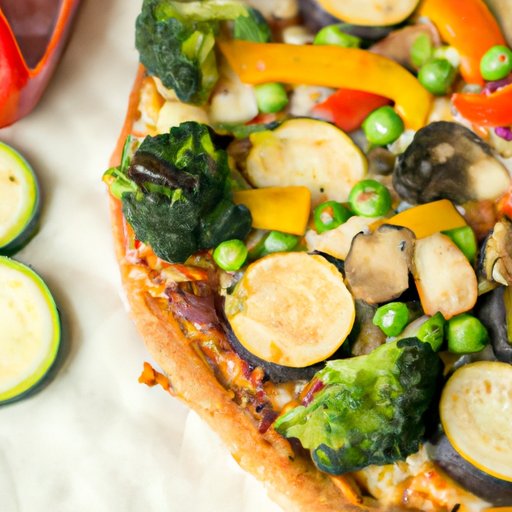Introduction
Vegetable pizzas have become increasingly popular over the years as people look for healthier options to satisfy their cravings. But is veggie pizza really healthy? In this article, we’ll explore the potential health benefits of veggie pizza and provide tips on how to make it even more nutritious without sacrificing taste.

Examining the Health Benefits of Veggie Pizza
Vegetables are a key component of any healthy diet, and they can offer many health benefits. According to the Centers for Disease Control and Prevention, “eating vegetables may reduce risk for heart disease, including heart attack and stroke.” They also contain essential vitamins and minerals that can help boost your immune system and improve overall health.
When it comes to veggie pizza, the health benefits depend largely on the ingredients used. For example, adding dark leafy greens like spinach and kale can provide important antioxidants and fiber. Other popular toppings like mushrooms and peppers are packed with vitamins and minerals. And using whole wheat flour instead of white flour can add extra fiber and protein to your pizza.
Comparing Nutrition Labels: Store-Bought vs Homemade Veggie Pizza
When it comes to store-bought veggie pizzas, it’s important to read the nutrition label. Many pre-made pizzas are high in sodium and saturated fat, which can be unhealthy if consumed in large amounts. It’s also important to watch out for added sugars, which can cause blood sugar spikes and weight gain.
Making your own veggie pizza at home is a great way to control the ingredients and ensure that you’re getting only the healthiest toppings. You can use whole wheat flour, lower-fat cheeses, and fresh vegetables. Plus, you can customize the recipe to your tastes – just make sure to avoid adding too much salt and sugar.
Exploring Alternative Ingredients for a Healthier Veggie Pizza
When making a veggie pizza, it’s important to choose the right ingredients. Popular toppings like pepperoni and sausage are high in saturated fat and sodium, so it’s best to avoid them. Instead, try adding lean proteins like chicken or turkey, as well as beans and legumes for extra fiber.
You can also add additional vegetables like broccoli and artichokes for a nutrient boost. If you’re looking to add some flavor, opt for herbs and spices instead of processed sauces. Garlic, oregano, basil, and red pepper flakes are all great options.

Creating a Balanced Meal with Veggie Pizza as the Main Course
Veggie pizza can be a great main course for a balanced meal. To ensure that you’re getting all the essential nutrients, pair your pizza with a side dish. Leafy greens like spinach and kale are a great option, as are roasted vegetables like sweet potatoes and carrots. Adding a serving of fruit is also a good idea – try pairing your pizza with a piece of fresh melon or a few slices of pineapple.
It’s also important to incorporate other healthy foods into your meal. Try adding legumes like chickpeas or lentils to your salad, or top your pizza with nuts and seeds for an extra dose of protein and fiber. Incorporating these foods can help balance out the meal and ensure that you’re getting all the essential nutrients.

How to Make Veggie Pizza More Nutritious Without Sacrificing Taste
Making your own veggie pizza is a great way to make sure that you’re getting all the essential nutrients without sacrificing taste. Here are a few tips for making your pizza more nutritious:
- Add protein: Incorporate lean proteins like chicken or turkey for an extra dose of nutrition. You can also add beans, legumes, and nuts for extra fiber and protein.
- Substitute whole wheat flour: Whole wheat flour has more fiber and protein than white flour, so it’s a great way to make your pizza more nutritious without sacrificing taste.
- Incorporate healthy oils: Olive oil and avocado oil are both rich in healthy fats and can help boost the nutrition of your pizza.
Conclusion
Veggie pizza can be an excellent source of nutrients with the right combination of ingredients. The key is to choose the right toppings, such as lean proteins, fresh vegetables, and healthy oils. Making your own veggie pizza at home is a great way to control the ingredients and ensure that you’re getting only the healthiest toppings. With a few simple tweaks, veggie pizza can be a delicious and nutritious meal.
Overall, veggie pizza can be a great addition to a balanced diet. By incorporating fresh vegetables, lean proteins, and healthy oils, you can make sure that you’re getting all the essential nutrients without sacrificing taste.
(Note: Is this article not meeting your expectations? Do you have knowledge or insights to share? Unlock new opportunities and expand your reach by joining our authors team. Click Registration to join us and share your expertise with our readers.)
